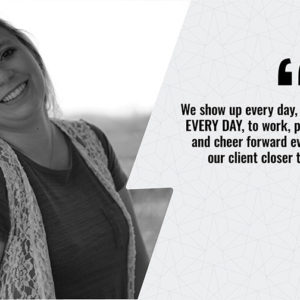Nothing changes in your life until you decide you need to change. It doesn’t matter what incentive is in front of you or what penalty is behind you — you will only change when you decide for yourself that change is necessary.
That’s true for you. And it’s true for everyone else around you.
That’s important to remember as a leader.
Just because you want to change and just because you want your people to change doesn’t mean that the people you are leading will see the need to change.
That can create a big problem for you — especially if you’re the type of person who feels compelled to keep leveling up. While it might seem obvious to you that growth is always important, and that changing towards improvement is necessary, it’s not obvious to everyone else.
And it won’t always be easy for you to change.
So what do you do when you want to change other people? What do you do when you feel like other people changing will actually make their life better for them?
What if that person is you?
1. Respect how difficult changing really is
The problem with changing is that it’s both new and uncomfortable. Even when you are excited about the possible positive outcomes, the first few times you try changing, you end up with miserable results. Almost always.
The pattern looks a little like this:
- You know you need to change, so you think about changing.
- Then you convince yourself to start changing.
- But changing is awkward and uncomfortable and feels horrible — even with great results.
- That forces you to decide whether or not to continue changing.
That’s the pattern — whether you’re in business trying to close deals or in a relationship where your partner tells you things have to change or they’re out.
Changing is difficult. That’s not an excuse. But it should impress upon you the importance of treating it with the seriousness that it deserves.
Changing isn’t easy. And it’s not automatic. It requires conscious work on your behalf.
Perhaps the biggest reason why leaders find it so difficult to lead change is that they don’t take the act of changing seriously enough.
They just add it to their list of things to do — like everything else. But changing isn’t like everything else. It’s more emotionally impactful. It requires more brainpower. More energy. More courage.
It’s new and wildly uncomfortable.
Which means it requires more of “you” to navigate.
If you’re a leader, covered up with six to seven hours of meetings and conference calls each day, you aren’t emotionally prepared to change.
Which is why most discussions around change quickly degenerate into a discussion about priorities and productivity.
To change in a meaningful way, you have to do more of the uncomfortable things that you’re not used to doing and less of the “productive things” that you can check off your list and feel good about each day.
But you know the difference in intensity and purpose. You’re giving change the respect that it deserves.
2. Focus on an overwhelming need to change
Have you ever noticed how easy it is to change when you need to change?
You might spend 50 years screaming “bloody murder” about how you’ll never eat green leafy vegetables, but once you’ve had a heart attack and the doctor tells you that you’re at high risk to have another one, it’s pretty amazing how quickly you decide you want to change.
Cold turkey. Overnight. It happens instantly.
Because it’s a mindset change.
The vegetables didn’t change their taste, and your taste buds didn’t magically evolve to appreciate the uninspiring taste of healthy food.
The only thing that changed was your desire to live. Your ambition to hold back the looming consequences of your actions.
When you strip away all the emotion, changing isn’t actually hard. But needing to change is very hard.
And then some days it’s not hard at all.
It’s the only option in front of you.
But when that day comes, where change is the only option in front of you, you might find yourself in a position where you’ve already wasted strength and life and the ideal opportunity to do something that truly transforms the world around you.
That’s a lesson that you need to share with your people, and remind yourself of each day:
- Take life seriously right now.
- Use each moment you have as an opportunity to be a better version of you.
- Push the limits of what you think it’s possible.
- Work harder than you think you should.
Put in the effort. Sweat. Bleed. Fight. Be possessed with a calling bigger than yourself. Need to change before you have to change.
3. Use momentum as your measuring stick
At face value, changing appears to be nearly impossible.
Long-time studies show that 70% of change management projects fail. That means that as a leader most of the changes you want to drive will fail — more than 2 out of 3 will end in disaster.
Which begs the question: “Is change really possible for business? And how do you measure it?”
Because if change isn’t going to happen, you should know that as early as possible.
You should be able to predict when something might work and if what you’re doing right now is (or is not) working. You should be able to predict a successful change.
What makes change nearly impossible is the metrics and measurements used to define and scale change. The truth is that there is really only one accurate predictor of successful change — momentum.
Any meaningful change starts small. So the evidences of successful change are largely unnoticed for a while.
Due to the raw dynamics of big business, momentum is the single best way to measure change.
Just going through a series of steps and exercises doesn’t cement the change you want to see become successful.
You have to build momentum, maintain momentum, and increase momentum around the change that you want to drive.
Momentum looks at different key performance indicators than revenue and profit and basic customer satisfaction. Momentum digs deeper at things like:
- How many fewer meetings can we have as a company and still communicate better?
- How many of our existing customers are offering their help to grow our business?
- How often are we thanked for our extra effort and told we are over-delivering?
- How are we creating and delivering memorable marketing and sales stories?
- How many of our customers are sharing (on their own) our story with ideal prospects?
This type of momentum is what delivers better results.
It’s not “skin deep”. It’s thoughtful and comprehensive.
And it’s what builds momentum. And makes change possible.
As you lead change, remember that life is full of seasons.
There is a time to be up and a time to be down. You’re going to find yourself celebrating success, another time scrambling to recover from what seems like impending doom.
There are moments when everything is good and you don’t feel the need to change — other moments where you can’t change fast enough.
Each one of us is going through these seasons at different times — and all at the same time.
Be the best you possible. Show the results that come from being willing to change. Accept and celebrate the hard changes others are willing to make in their pursuit of getting to that next level. Stay true to your mission for leveling up.
Some days it’s going to feel like everything is working perfectly. On quite a few other days, you’re going to feel like absolutely nothing is working.
Take a deep breath. Keep moving towards where you want to be.
Changing is worth it.





